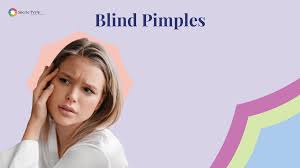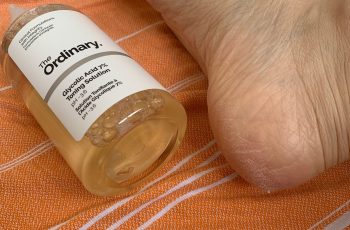
Blind Pimples: How to Get Rid of Those Stubborn Hard Pimples Under the Skin
Are you tired of those pesky pimples that lurk beneath the surface of your skin, seemingly impossible to get rid of? This under skin acne is bothersome to many people and you’re not alone. I have at least 5 patients a week in my dermatology practice that have these hard bumps under their skin and come in to have them removed. Hard deep pimples are called nodular acne if they are 1cm or larger. Blind pimples can turn into epidermal inclusion cysts( EICs) if not treated properly.. These blind pimples can be the bane of many people’s existence because unlike regular pimples that have a visible white or blackhead, these hard bumps under the skin are deep and do not come to a head. They cannot be popped and get worse when picked.
In this article, we will explore effective strategies to get rid of and prevent these hard lumps under the skin and regain smooth, clear skin. From natural remedies to dermatologist-recommended treatments, we’ve got you covered. Discover the power of skin care ingredients in reducing inflammation and promoting healing of these hard pimples under the skin. Learn about the importance of a consistent skincare routine and how to prevent blind pimples. Say goodbye to the frustration and embarrassment of bumpy skin on the face by getting on the best skin care routine to prevent blind pimples. So, if you’re ready to take control of your skin and bid farewell to blind pimples that won’t go away, let’s dive in and discover the best skin care products to clear these hard bumps and lumps forever.
What Are Hard Pimples Under The Skin?
Hard pimples in the skin are usually divided by dermatologists into two categories:
Inflammatory acne lesions
Non-inflammatory acne lesion
Inflammatory lesions that are less than 1cm in size are called acne papules. If they are larger than 1cm, they are called acne nodules. If they have a head or pus in them they are called inflammatory acne pustules.
Noninflammatory acne lesions are comedones.
Hard pimples under the skin with no head on them (blind pimples) are called inflammatory acne papules by dermatologists.
What else can hard bumps under the skin be?
Blind Pimples
Blind pimples are hard bumps under the skin that do not have a head or visible pus. They are believed not to have an opening to the surface but if you look closely you can open see a tiny pore. Blind pimple is not a scientific name. These are called inflammatory acne papules.
A blind pimple may gradually come to a head over days or weeks as the contents expand, allowing it to eventually drain, or it may remain as a tender lump under the skin, or it may slowly resolve over many months.
Epidermal Inclusion Cyst (EIC)
Hard pimples that do not go away and have a smelly discharge may be epidermal inclusion cysts (EIC). These stay there for month or years and won’t go away on their own.
Sebaceous Cyst
This is the same thing as an epidermal inclusion cyst.
Milia
Milia are small white seed looking bumps. They are different than blind pimples because you can see the hard rice looking “seed” of packed keratin inside them. This is because they are closer to the skin’s surface than an inflammatory acne papule is. Milia are deep comedones. Milia are not cysts but they can turn into EICs if picked or removed improperly.
What causes blind pimples?
Blind pimples, or epidermal inclusion cysts (EICs), occur when excess oil, dead skin cells, and bacteria clog the pores. Unlike regular pimples, blind pimples do not have a visible white or blackhead, making them harder to treat. The trapped oil and bacteria cause inflammation deep within the skin, resulting in the formation of hard, painful bumps. These blind pimples can be caused by several factors, including hormonal changes, excess oil production, poor skincare routine, and genetic predisposition.
Characteristics of Blind Pimples
Blind pimples are characterized by their deep, painful nature and lack of a visible head. They often develop as small, red bumps under the skin that gradually grow in size. The skin around the blind pimple may feel warm and tender to the touch. Unlike regular pimples, blind pimples don’t come to a head and cannot be popped. Attempting to squeeze or pop them can lead to further inflammation and potential scarring. These characteristics make blind pimples frustrating and challenging to treat.
How to Prevent Blind Pimples
Prevention is key when it comes to blind pimples. By adopting a consistent skincare routine and making a few lifestyle changes, you can significantly reduce the likelihood of developing these stubborn bumps.
To prevent blind pimples, it’s important to avoid touching your face with dirty hands, as this can transfer bacteria and irritants to the skin. Change your pillowcases and makeup sponges regularly, as they can harbor bacteria and oil that can contribute to breakouts. Incorporate a weekly exfoliation treatment such as a mask to remove dead skin cells and unclog pores. Lastly, be mindful of your diet and try to minimize the consumption of sugary and greasy foods, as they can contribute to excess oil production and inflammation in the skin.
These are tips to prevent blind pimples from occurring:
Cleanse your face twice a day with the right cleanser for your Baumann Skin Type.
Incorporate a toner or serum containing salicylic acid or benzoyl peroxide into your routine to further cleanse and minimize pores.
Avoid moisturizers with comedogenic ingredients
Add a retinoid to your routine
Take the skin type quiz to get on a skin care routine to help prevent breakouts.
Skin Care Products To Treat Blind Pimples
Home remedies for treating blind pimples
Home remedies can be effective in reducing inflammation and promoting healing of blind pimples. One popular remedy is applying a warm compress to the affected area for 10-15 minutes, several times a day. The warmth helps to increase blood circulation and help the skin heal itself.
Another natural remedy is tea tree oil, which has antimicrobial properties that can help kill bacteria and reduce inflammation. Dilute tea tree oil with a carrier oil, such as jojoba oil, and apply it to the blind pimple using a cotton swab. Leave it on overnight and rinse it off in the morning.
Other natural remedies include applying aloe vera gel, apple cider vinegar, or honey to the affected area. These remedies can help soothe the skin and reduce redness and inflammation.
OTC treatments for blind pimples
Over-the-counter treatments for blind pimples
There are several over-the-counter treatments that can help clear blind pimples. Look for products containing ingredients such as benzoyl peroxide or salicylic acid, which are known for their ability to unclog pores and reduce acne-causing bacteria.
These ingredients can be found in cleansers, spot treatments, and acne creams. One of the best products to treat blind pimples is Skinceuticals Blemish and Age Defense Salicylic Acid Serum. I was involved in a study that compared this product to prescription Benzaclin. Both had good results treating inflammatory acne lesions. (9)
Combining salicylic acid with retinol is a good way to get rid of blind pimples, but Sensitive Baumann Skin Types may not be able to tolerate these two strong ingredients together.
Be patient with the results, as it may take a 4-8 weeks of consistent use to see improvements.
Using a strong retinoid can speed up the desquamation cycle of the skin and help clear blind pimples faster.
Listed below are some very strong retinol serums to put directly on the blind pimple. These may be too irritating to use on your entire face so use them for spot treatments only.
[[T17]]
Prescription Treatments for Blind Pimples
There are many prescription acne treatments that contain tretinoin, adapalene, tazarotene, antibiotics, or benzoyl peroxide, These help prevent acne. Retinoids can cause purging which helps the blind pimple come to the surface.
However, the best and fastest way to get rid of a blind pimple is using a prescription steroid cream like triamcinolone. This works but you can only do it in a pimple emergency because there are many downsides to using a steroid on pimples.
Steroids on the face used for more than a few days can cause:
skin thinning
stretch marks
steroid acne
perioral dermatitis
telangiectasias (spider veins)
These side effects are why dermatologists usually do not prescribe steroids to tret blind pimples.
Professional treatments for blind pimples
Professional treatments for blind pimples
There are many professional treatments for blind pimples including chemical peels, laser therapy, and photodynamic therapy, but these are not as effective as a steroid injection.
These treatments target the underlying causes of blind pimples and can provide long-term results, but they do not really make blind pimples shrink faster. (Sometimes the 585nm vascular can help reduce inflammation and speed up resolution of a pimple . However, the best treatment is to prevent blind pimples by using the correct skin care routine for your Baumann Skin Type.
Injections for blind pimples
Dermatologists have access to a range of professional treatments that can effectively eliminate blind pimples under the skin. The best way to get rid of a blind pimple overnight is with an intralesional corticosteroid injection. This must be done by a doctor. This involves injecting a corticosteroid directly into the blind pimple to reduce inflammation and promote healing.
This treatment can provide quick relief and significantly reduce the size and redness of the blind pimple within a few days.
what are pimple extractions
Extractions
Another professional treatment option is extraction, where a dermatologist uses specialized tools to remove the contents of the blind pimple. However, blind pimples cannot be extracted They do not have a central pocket of pus and are not ready to be extracted.
Extractions can turn blind pimples into cysts! This procedure should only be performed by a trained professional who known when to extract and when to inject to minimize the risk of scarring or infection.
Dos and don’ts for dealing with blind pimples
When dealing with blind pimples, it’s important to follow certain dos and don’ts to minimize irritation and promote healing. Resist the urge to pick, squeeze, or pop the blind pimple, as this can worsen inflammation and increase the risk of scarring. Applying excessive pressure can also push the infection deeper into the skin, leading to more extensive breakouts and cysts.
Instead, focus on gentle cleansing and applying appropriate acne treatments mentioned above. Avoid using harsh or abrasive scrubs that can aggravate the skin and increase the amount of blind pimples by disrupting desquamation. Stick to gentle, non-comedogenic products that won’t clog the pores. Lastly, use the right skin care for your Baumann Skin Type and be patient with your skincare routine and give the treatments time to work. Without a steroid injection, blind pimples can take several weeks to resolve completely, so consistent and diligent care is essential.
When to see a dermatologist for blind pimples
When to see a dermatologist for blind pimples
While most cases of blind pimples can be effectively treated with home remedies or over-the-counter treatments, there are instances where a dermatologist’s expertise is necessary. If you have severe or persistent blind pimples that do not respond to at-home treatments, it’s important to seek professional help. A dermatologist can assess your skin condition, determine the underlying causes of your blind pimples, and recommend appropriate treatments such as anti-inflammatory steroid injections into the lesion. They may prescribe stronger topical medications like retinoids or oral antibiotics to target the bacteria and inflammation. In some cases, they may suggest more advanced treatments, such as isotretinoin or hormonal therapies, for long-term management of acne. Remember, a dermatologist has the knowledge and experience to provide personalized solutions based on your skin type and specific concerns.
Blind pimples can be a frustrating and stubborn problem to deal with, but you can get rid of them forever with the right skin care routine and habits (don’t pick!). Take the quiz to find out with medical grade skin care brands will work best to prevent blind pimples in your skin type.


